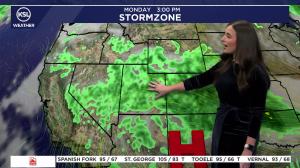Estimated read time: 3-4 minutes
This archived news story is available only for your personal, non-commercial use. Information in the story may be outdated or superseded by additional information. Reading or replaying the story in its archived form does not constitute a republication of the story.
ALBUQUERQUE, N.M. (AP) — In a story May 19 about a historical document related to the death of the former sheriff who is credited with killing Billy the Kid, The Associated Press, relying on information provided by Dona Ana County, erroneously reported the date of the coroner's jury report. The document is dated Feb. 29, 1908, not July 9, 1908.
A corrected version of the story is below:
Document details death of lawman who killed Billy the Kid
Officials in a southern New Mexico county say they have found a document inside a box of old records that sheds a little more on light on the death of the Old West lawman who gained fame for killing Billy the Kid
By SUSAN MONTOYA BRYAN
Associated Press
ALBUQUERQUE, N.M. (AP) — A century-old document found inside a box of unarchived records in a southern New Mexico county is shedding a little more light on the shooting death of the Old West lawman who gained fame for killing Billy the Kid.
Dated Feb. 29, 1908, the nearly illegible handwritten coroner's jury report refers to the investigation of the death that day of Pat Garrett, who served as sheriff in Lincoln and Dona Ana counties before being appointed as a customs collector along the U.S.-Mexico border.
Historians have searched for years for additional official documents beyond court records and newspaper articles from the time that assigned blame for Garrett's shooting death since some have their own theories about who pulled the trigger.
Signed by several justices of the peace and coroners, the document states that Garrett was reported dead in Dona Ana County in the territory of New Mexico about five miles northeast of Las Cruces.
They found that "the deceased came to his death by gunshot wounds inflicted by one Wayne Brazel."
Some historians have said that the one witness to the shooting never testified and records show Brazel was acquitted after a one-day trial in which his attorney successfully argued self-defense.
The document was found in November by Angelica Valenzuela, the records and filing supervisor with the county clerk's office, as part of a preservation effort that involved records spanning the last half of the 1800s through the mid-1960s.
"She knew as soon as she saw it that it was worth gold," county spokesman Jess Williams said of the signed jury report.
Pointing to the discovery, the county is seeking additional grant funding for its work to preserve historical records and make them more accessible.
"Our goal is to provide full access to the public," said County Clerk Scott Krahling. "Since family roots run deep in Dona Ana County, our hope is that these documents enrich our stories and get more people excited about our history and culture."
For now, the document is locked away in a safety deposit box. The county is planning a public unveiling next month.
Arizona State University professor emeritus Robert Stahl is among those who have written in support of more preservation funding for the county.
"Once they are found, filed and made available, hundreds of historians, genealogists and just 'plain folk' will come from all over the world and spend millions of dollars each year to get their eyes on what you have," he wrote. "You are sitting on a gold mine in more ways than one."
Local historian Christopher Schurtz is among those who have combed through the county's records, which include everything from Old West files to the city of Las Cruces' original plat.
"As a historian, I believe the more that the people who hold these records make this stuff available and the more that is preserved, the better," Schurtz said.
As part of the effort, the clerk's office plans to institute one-hour, supervised appointments for people interested in viewing archived historical documents.
The most significant items uncovered during the archival process will be turned over to the state records center in Santa Fe for long-term preservation, officials said.
Thousands of documents still have to be reviewed, Krahling said.
"We know some of what we have, and it's pretty exciting," he said.
Copyright © The Associated Press. All rights reserved. This material may not be published, broadcast, rewritten or redistributed.







